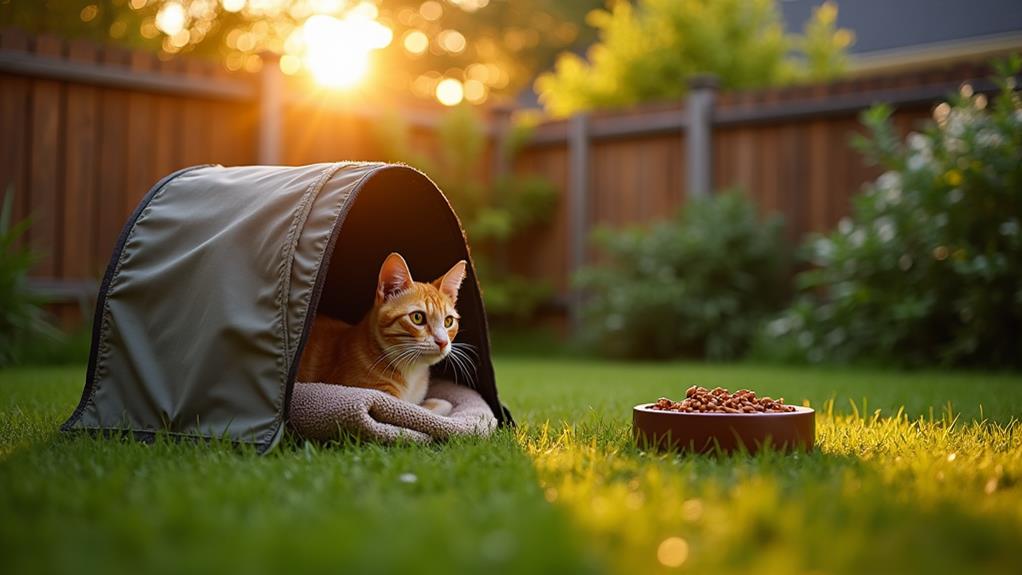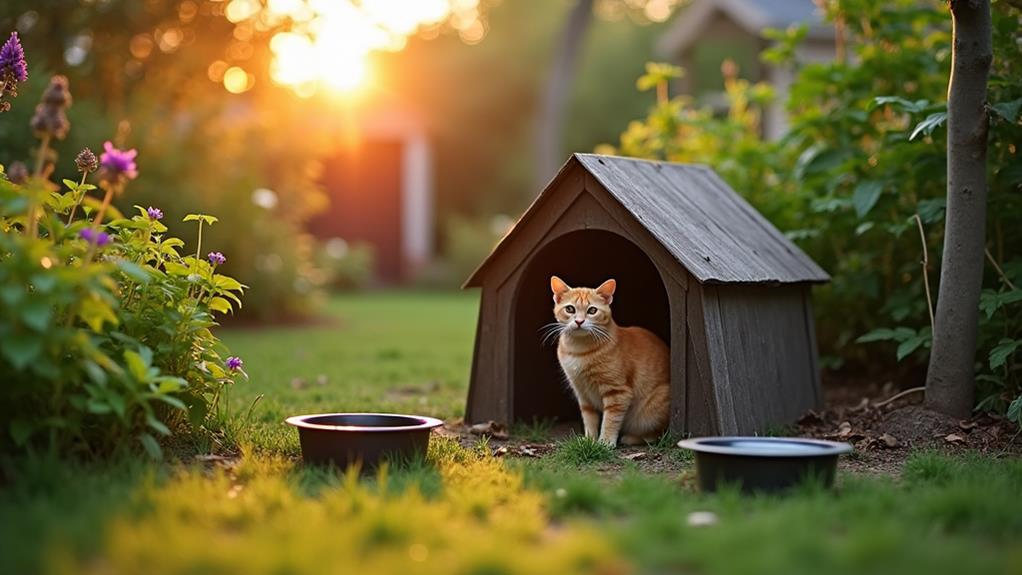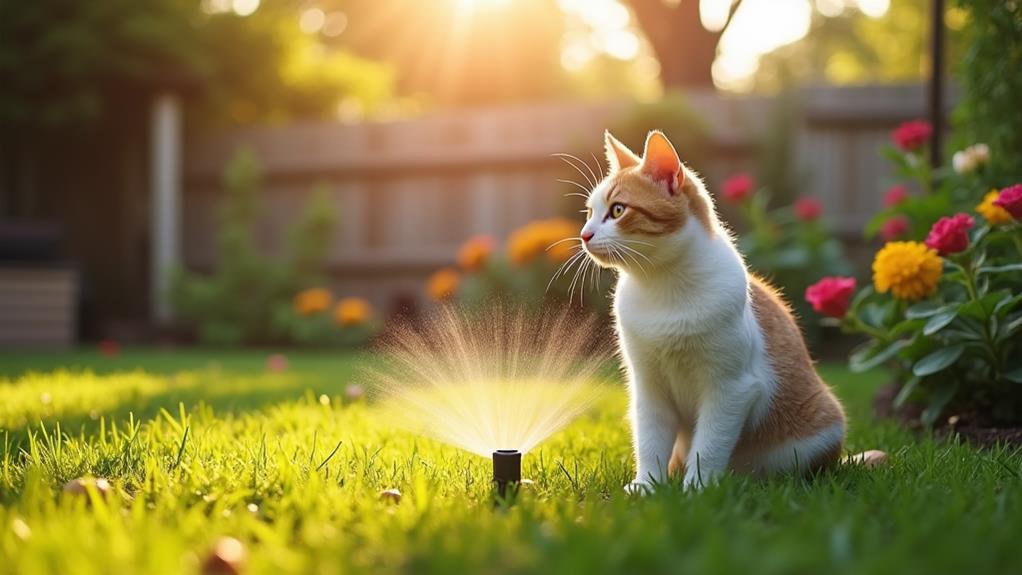How to Get Rid of a Feral Cat in Your Yard: Effective Solutions

To effectively manage feral cats in your yard, start by eliminating food sources. Secure trash cans and avoid leaving pet food outside. Use motion-activated sprinklers or ultrasonic devices to deter them. Install chicken wire or lattice to block entry points, and cover garden beds with sharp materials like pebbles. Consider Trap-Neuter-Return (TNR) programs to control their population humanely. Understanding the difference between stray and feral cats is essential, as each requires a different approach. Combine deterrents and work with neighbors to create a less appealing environment. By implementing these strategies, you'll learn to manage feral cats effectively.
Preventing Cat Access
To effectively prevent feral cats from accessing your property, start by securing your trash cans with tight lids or bungee cords. This simple step is essential in keeping feral cats away, as unsecured trash can be an easy food source that attracts them. Alongside this, consider using physical barriers like chicken wire or lattice to block any entry points these cats might use to get into your yard. Such barriers are effective in preventing cat access while being relatively easy to install around your property.
To further deter feral cats, scatter fragrant items like orange peels, vinegar, or lavender oil around potential entry areas. These scents are known to repel cats without causing them harm. Adding these natural deterrents creates an unwelcoming environment for the cats, making it less likely for them to linger on your property.
Incorporating these strategies not only helps in keeping cats away but also maintains the cleanliness and safety of your outdoor space. By combining secure trash management, physical barriers, and fragrant deterrents, you're proactively taking steps in preventing cat access to your yard, ensuring it remains a peaceful and cat-free zone.
Garden Protection Techniques
While securing your property from feral cats is significant, protecting your garden requires extra strategies. You can start by using plastic carpet runners with the spiked side facing up, lightly covered in soil. This creates an uncomfortable surface that effectively deters cats from entering your garden beds. Furthermore, embedding small-gauge chicken wire beneath the soil in your flower beds makes it difficult for cats to dig, providing a straightforward feral cat management technique.
To further discourage these feline visitors, arrange branches in lattice patterns over any exposed soil. This setup prevents cats from lounging and digging, maintaining the integrity of your garden. Covering the exposed ground in flower beds with large river rocks also makes these areas less appealing for wandering or digging by community cats.
For a natural deterrent, introduce the herb rue or sprinkle dried rue around your garden. The scent of rue is known to be unpleasant to cats, offering a humane society-approved method to keep them at bay. By implementing these strategies, you can protect your garden effectively while being mindful of the cats' well-being, ensuring a peaceful coexistence with these neighborhood visitors.
Shelter and Feeding Options

Creating safe spaces for feral cats in your neighborhood can greatly reduce their disruptive presence in your yard. Providing outdoor shelters in secluded areas offers them a secure place, keeping them from seeking refuge in your garden or under your porch. Setting up designated feeding stations with a regular schedule guarantees they're well-fed, which decreases their need to scavenge around your property. This approach not only manages the feral cat population but also supports Trap-Neuter-Return (TNR) efforts by making it easier to monitor and trap them when needed.
To keep these areas orderly, maintain strict cleanliness around feeding stations. Promptly clean up any spilled food to discourage lingering and prevent attracting other wildlife. Furthermore, consider using litter boxes filled with sand or peat moss in strategic spots to manage their bathroom habits, reducing unwanted messes.
Here's how you can effectively set up these options:
- Secluded shelters: Place in quiet corners away from your home.
- Designated feeding stations: Set up with regular feeding times.
- Cleanliness: Regularly remove leftover food and debris.
- Litter management: Use sand or peat moss for easy cleanup.
Community and Neuter Initiatives
Harnessing community and neuter initiatives can make a significant difference in managing feral cat populations. By promoting Trap-Neuter-Return (TNR) programs, you can effectively curb reproduction and reduce nuisance behaviors like yowling and spraying. TNR involves humanely trapping feral cats, having them spayed or neutered, and then returning them to their original locations. This approach helps stabilize cat numbers and improve their quality of life.
Engage with organizations like Alley Cat Allies to access resources and support for humane feral cat management. These groups can assist you in raising community awareness about the benefits of spaying/neutering and responsible pet ownership. By spreading the word, you can help reduce the number of feral cats entering the population.
Collaborate with local animal control services to guarantee humane trapping and compliance with local laws. This partnership can facilitate the relocation of feral cats when necessary, promoting their welfare and aligning with community goals. Implementing regular feeding schedules and maintaining clean feeding areas can also help manage feral cats, encouraging them to stay within safe zones. Together, these strategies foster a compassionate and effective approach to feral cat management in your neighborhood.
Deterrent Devices and Solutions

In the matter of managing feral cats, deterrent devices and solutions offer practical ways to keep them at bay without harm. Motion-activated sprinklers like CatStop or ScareCrow are superb options. They use infrared technology to detect a cat's presence and deliver a brief spray of water, surprising the cat and urging it to find a new hangout. Motion-activated ultrasonic sound devices are another great choice, emitting high-frequency sounds that cats dislike, yet remain inaudible to humans. These are perfect for discouraging territorial behaviors without causing harm.
For a more tactile solution, consider using plastic mats such as Cat Scat mats. These have harmless spikes that make surfaces uncomfortable for cats, deterring them from lounging or digging in the area. Furthermore, laying chicken wire in garden beds or just beneath the soil creates an uncomfortable barrier, effectively preventing cats from digging or accessing certain spots.
Here's how to visualize these solutions:
- Motion-activated sprinklers: A surprise spray that sends cats running.
- Ultrasonic sound devices: A silent, humane deterrent.
- Plastic mats: Spiky surfaces that say "stay away."
- Chicken wire: An underground fortress against digging.
Remember to regularly monitor and adjust the placement of these deterrent devices to maintain their effectiveness.
Understanding Stray vs. Feral Cats
Understanding the distinction between stray and feral cats is vital for anyone trying to manage cat populations effectively. Stray cats are typically lost or abandoned pets, often seeking human interaction and displaying more sociable behavior. You'll notice that they might have collars and may even approach you for food or attention. On the other hand, feral cats are wild, avoiding human contact and showing more fearful behaviors. They live in colonies, relying on hunting and scavenging for survival.
When it comes to management strategies, these behavioral differences play a significant role. Stray cats might be lured by food and can often be reunited with their owners. In contrast, feral cats require more strategic interventions like Trap-Neuter-Return (TNR). This approach is essential because feral cats can reproduce rapidly, with females capable of having multiple litters annually, leading to unchecked population growth.
Implementing TNR for feral cats helps control this growth, stabilizing the colony without harm. Understanding these distinctions not only aids in choosing the right approach but also guarantees humane and effective management of cat populations, preventing further complications in urban areas.
Creating an Unwelcoming Environment

Why do feral cats keep coming to your yard? It's likely because your outdoor space provides shelter, food, or comfort. To create an unwelcoming environment and discourage these stray and feral invaders, start by blocking access to potential shelters. Seal off entry points to porches and sheds, using barriers to make these areas less appealing. This tactic serves as effective pest control against these invasive species.
Consider making your garden beds uncomfortable for lounging and digging. Spread sharp materials like pebbles, eggshells, or plastic carpet runners with the spiked side up. Furthermore, install motion-activated sprinklers that surprise feral cats with a harmless burst of water, deterring them from your property.
Remove any food sources that might be inadvertently feeding the cats. Secure trash in animal-proof containers and clean outdoor grills to eliminate enticing odors. Ultrasonic devices that emit high-frequency sounds, inaudible to humans, can also be a significant deterrent.
Visualize these tactics:
- Seal entry points to block potential shelters.
- Spread sharp materials in garden beds.
- Use motion-activated sprinklers for a surprise deterrent.
- Remove food sources to prevent feeding the cats.
With these steps, you'll encourage them to find refuge elsewhere, minimizing the need for animal control interventions.




